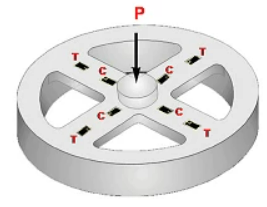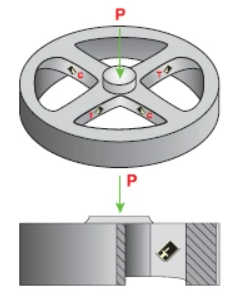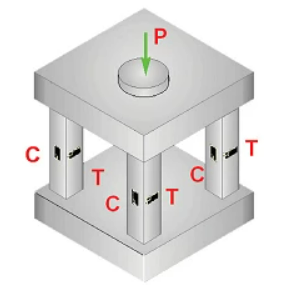

Measuring Load

Assess Your Testing Needs
Many measurement sensors, such as accelerometers and load cells generate DC voltages that can be measured. There are considerations that come along with each measurement and sensor type. This guide will explain general DC voltage measurements that do not involve sensor setup. Voltage is the simplest of the different types of analog measurements, and yet still presents unique challenges regarding noise considerations.
Research & Select the Right Equipment
Research and select the right equipment and software for your testing process. Consider factors such as test accuracy, test speed, ease of use, scalability, and compatibility with your existing manufacturing process. Consult with experts in the field, attend trade shows and conferences, and request demonstrations or trials to evaluate different options.
Design Test Fixtures
Design test fixtures that securely hold the PCBs, provide proper alignment and contact, and allow for easy insertion and removal of the boards. Consider the specific requirements of your PCB designs and ensure that the test fixtures can accommodate different board sizes and configurations. Test the fixtures with sample PCBs to ensure proper functionality.
Develop Test Sequences & Parameters
Develop test sequences and parameters that accurately reflect your testing requirements. This includes defining the order of tests, the specific measurements and analysis to be performed, and the pass/fail criteria. Consider the complexity of your test procedures and ensure that the automated testing system can handle them accurately and consistently. Test the sequences and parameters with sample PCBs to ensure accurate and reliable results.
Deploy and Validate
Develop test sequences and parameters that accurately reflect your testing requirements. This includes defining the order of tests, the specific measurements and analysis to be performed, and the pass/fail criteria. Consider the complexity of your test procedures and ensure that the automated testing system can handle them accurately and consistently. Test the sequences and parameters with sample PCBs to ensure accurate and reliable results.
Measuring Load
This guide helps you to understand the fundamentals of load measurements and how different sensor specifications impact load cell performance in your application. After you decide on your sensors, consider the required hardware and software to properly condition, acquire, and visualize load measurements.
What are Force and Load?
Force is the measure of interaction between two or more bodies and for every action there is an equal and opposite reaction. Force is also defined as a push or pull on an object. It is a vector quantity with magnitude and direction.
Load is a term which refers to the force exerted on a structure or body. The SI unit for force or load is the Newton (N). Load cells directly measure force or weight. These sensors convert mechanical force into electrical signals by measuring deformity produced by the force. An application of these devices is measuring dry materials in a hopper. A measure of the weight through a load cell yields a measure of the quantity of the material in the hopper.
Measuring Load
The way to measure load is using a load cell and the most commonly used load cell is the strain gage. Generally, you use a beam assembly that has several strain gages mounted in a Wheatstone bridge configuration so that the application of a force causes a strain upon gages actively measuring. These devices are traditionally calibrated for the force to be directly related to the resistance change. More rare pneumatic and hydraulic load cells translate force into pressure measurements. When force is applied to one side of the piston or diaphragm, the amount of pressure (pneumatic or hydraulic) applied to the other side to balance that force is measured. This rest of this white paper focuses on strain gage or bridge-based load cells.
The most critical mechanical component of a load cell or strain gage transducer is the structure (spring element). The structure reacts to the applied load and focuses that load into an isolated, uniform strain field where strain gages can be placed for load measurement. The three common load cell structure designs—multiple-bending beam, multiple column, and shear web—form the basic building blocks for all possible load cell profiles and/or configurations.
Multiple Bending Beam, Multiple Column, Shear Web
Figure 2. Load cell structure designs mount strain gages to measure compression and tension in different ways. [1].
Multiple-bending beam load cells are low capacity (20 to 22K N) and feature a circular spring element that is adaptable to low-profile transducers. It contains four active gages or sets of gages per bridge arm that ensures pairs are subjected to equal and opposite strains of tension and compression.
Multiple-column load cells consist of multiple columns for higher capacity (110K to 9M N). This arrangement allows for bridge arms to contain four active strain gages, with two aligned along the principal axis of strain and the other two in the traverse direction to allow for Poisson’s effect.
Shear-web load cells have a medium capacity (2K to 1M N) and use a wheel form with radial webs subject to direct shear. The mutliple strain gages per bridge arm are bonded to the sides of the web.
Choosing the Right Load Cell
Load cells operate according to two modes: a compression mode, during which a weight sits on one or more load cells, and a tension mode, during which a weight hangs directly from one or more load cells. You can design the different load cell structures discussed in the previous section using any of these configurations for compression-only forces, or for both a tension and compression force.
Beyond the principal measurement, its recommended to select a load cell primarily based on capacity, accuracy, and physical mounting constraints. One cannot determine expected performance by any one factor. It is critical to pinpoint it through a combination of different sensor parameters and the way you designed the load cell into your system. Refer to the table to compare the range, accuracy, and sensitivity different load cell types.

Capacity—Define and set your minimum and maximum capacity requirements. Be sure to select the capacity over the maximum operating load including anything extra before selecting a load cell. The load capacity must be capable of supporting the following:
Weight of the weighing structure (dead load)
Maximum live load that can be applied (including any static overload)
Additional overload arising from external factors such as wind loading or seismic activity
Measurement frequency—Load cells are designed for general-purpose use or are fatigue-rated to withstand millions of load cycles with no effect on performance. General-purpose load cells are designed for static frequency load applications. They typically survive up to 1 million cycles depending on the load level and transducer material. Fatigue-rated load cells are typically designed to achieve 50 million to 100 million fully reversed load cycles, depending on the load level and amplitude.
Physical and environmental constraints—One key characteristics to consider is how you are integrating the load cell into your system. Identify beforehand any physical restrictions that limit size (ex. width and length) or the way the load cell is mounted. Consider how the system will operate and what the worst-case operating conditions may be—the widest temperature range, the smallest weight change required to be measured, the worst environmental conditions (flood, tempest, seismic activity), and the maximum overload conditions.





